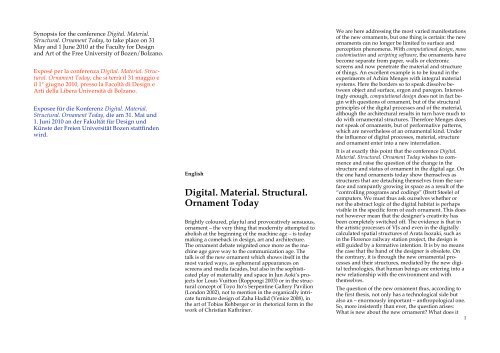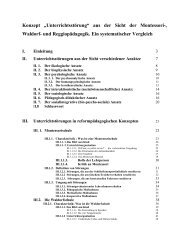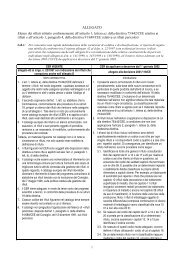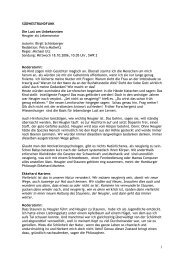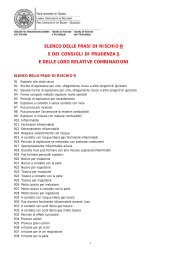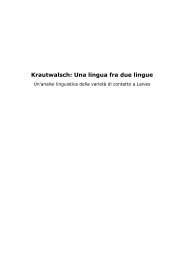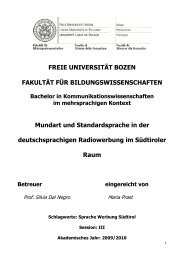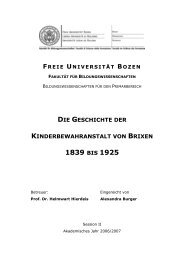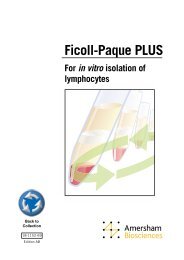Digital. Material. Structural. Ornament Today - Freie Universität ...
Digital. Material. Structural. Ornament Today - Freie Universität ...
Digital. Material. Structural. Ornament Today - Freie Universität ...
You also want an ePaper? Increase the reach of your titles
YUMPU automatically turns print PDFs into web optimized ePapers that Google loves.
Synopsis for the conference <strong>Digital</strong>. <strong>Material</strong>.<br />
<strong>Structural</strong>. <strong>Ornament</strong> <strong>Today</strong>, to take place on 31<br />
May and 1 June 2010 at the Faculty for Design<br />
and Art of the Free University of Bozen/Bolzano.<br />
Exposé per la conferenza <strong>Digital</strong>. <strong>Material</strong>. <strong>Structural</strong>.<br />
<strong>Ornament</strong> <strong>Today</strong>, che si terrà il 31 maggio e<br />
il 1° giugno 2010, presso la Facoltà di Design e<br />
Arti della Libera Università di Bolzano.<br />
Exposee für die Konferenz <strong>Digital</strong>. <strong>Material</strong>.<br />
<strong>Structural</strong>. <strong>Ornament</strong> <strong>Today</strong>, die am 31. Mai und<br />
1. Juni 2010 an der Fakultät für Design und<br />
Künste der <strong>Freie</strong>n <strong>Universität</strong> Bozen stattfinden<br />
wird.<br />
English<br />
<strong>Digital</strong>. <strong>Material</strong>. <strong>Structural</strong>.<br />
<strong>Ornament</strong> <strong>Today</strong><br />
Brightly coloured, playful and provocatively sensuous,<br />
ornament – the very thing that modernity attempted to<br />
abolish at the beginning of the machine age – is today<br />
making a comeback in design, art and architecture.<br />
The ornament debate reignited once more as the machine<br />
age gave way to the communication age. The<br />
talk is of the new ornament which shows itself in the<br />
most varied ways, as ephemeral appearances on<br />
screens and media facades, but also in the sophisticated<br />
play of materiality and space in Jun Aoki’s projects<br />
for Louis Vuitton (Roppongi 2003) or in the structural<br />
concept of Toyo Ito’s Serpentine Gallery Pavilion<br />
(London 2002), not to mention in the organically intricate<br />
furniture design of Zaha Hadid (Venice 2008), in<br />
the art of Tobias Rehberger or in rhetorical form in the<br />
work of Christian Kathriner.<br />
We are here addressing the most varied manifestations<br />
of the new ornaments, but one thing is certain: the new<br />
ornaments can no longer be limited to surface and<br />
perception phenomena. With computational design, mass<br />
customisation and scripting software, the ornaments have<br />
become separate from paper, walls or electronic<br />
screens and now penetrate the material and structure<br />
of things. An excellent example is to be found in the<br />
experiments of Achim Menges with integral material<br />
systems. Here the borders so to speak dissolve between<br />
object and surface, ergon and paregon. Interestingly<br />
enough, computational design does not in fact begin<br />
with questions of ornament, but of the structural<br />
principles of the digital processes and of the material,<br />
although the architectural results in turn have much to<br />
do with ornamental structures. Therefore Menges does<br />
not speak of ornaments, but of performative patterns,<br />
which are nevertheless of an ornamental kind. Under<br />
the influence of digital processes, material, structure<br />
and ornament enter into a new interrelation.<br />
It is at exactly this point that the conference <strong>Digital</strong>.<br />
<strong>Material</strong>. <strong>Structural</strong>. <strong>Ornament</strong> <strong>Today</strong> wishes to commence<br />
and raise the question of the change in the<br />
structure and status of ornament in the digital age. On<br />
the one hand ornaments today show themselves as<br />
structures that are detaching themselves from the surface<br />
and rampantly growing in space as a result of the<br />
“controlling programs and codings” (Brett Steele) of<br />
computers. We must thus ask ourselves whether or<br />
not the abstract logic of the digital habitat is perhaps<br />
visible in the specific form of each ornament. This does<br />
not however mean that the designer’s creativity has<br />
been completely switched off. The evidence is that in<br />
the artistic processes of VJs and even in the digitally<br />
calculated spatial structures of Arata Isozaki, such as<br />
in the Florence railway station project, the design is<br />
still guided by a formative intention. It is by no means<br />
the case that the hand of the designer is obsolete. On<br />
the contrary, it is through the new ornamental processes<br />
and their structures, mediated by the new digital<br />
technologies, that human beings are entering into a<br />
new relationship with the environment and with<br />
themselves.<br />
The question of the new ornament thus, according to<br />
the first thesis, not only has a technological side but<br />
also an – enormously important – anthropological one.<br />
So, more insistently than ever, the question arises:<br />
What is new about the new ornament? What does it<br />
1
change in the relationship between human beings and<br />
environment? How does it affect how we feel and our<br />
relationship with things? Would we be better, in view<br />
of its process-oriented nature, to speak directly of ornamental<br />
processes? How does the new ornament<br />
differ from machine ornament and classical ornament,<br />
and where in turn do affinities and continuities exist?<br />
Is every moiré effect, every computer-generated pattern<br />
and every pixel-like structure on a media façade<br />
now a new ornament?<br />
According to the second thesis, history itself makes<br />
clear that the recurrence of the question of ornament is<br />
always an indication of a fundamental change in culture.<br />
This holds true for the debates on ornament in<br />
the period of early modernity as well as for their return<br />
in the 1960s in the ornamental figures of early<br />
computer graphics (Nake, Noll) and in the structural<br />
ornament of structuralism (Candilis, A. van Eyck).<br />
This is also true for the abstract ornaments of concrete<br />
art, from pop art and op art and also for the allegorical<br />
and metaphoric ornaments of postmodernism (A.<br />
Mendini, E. Sottsass, M. Thun, Arata Isozaki). Modernity<br />
sharpens its theoretical concept on ornament.<br />
Opinions diverge when it comes to ornament, but less<br />
– as is generally held – in the sense of questions of<br />
taste than that the central formative questions and<br />
problem areas of an age crystallise on it.<br />
<strong>Ornament</strong>, according to the third thesis, is where the<br />
re-conceptualisation of culture in the ever-changing<br />
cultural force field takes place. This is worth examining.<br />
The new ornament seems in this sense to indicate<br />
an end-point and a turning-point, the “end of the Albertian<br />
paradigm”. Alberti believed that the strength<br />
of the Renaissance lay essentially in the separation of<br />
the intellectual design process from direct realisation<br />
by the craftsman. But, as Mario Carpo shows, digital<br />
tools tend to abolish this separation that had held for<br />
over 500 years between the “intellectual act of design”<br />
and the “material act of building”. What can now be<br />
seen is a new “interactive linkage” between the cognitive<br />
processes of design, i.e. the thinking of the things,<br />
and the material processes, i.e. the making of the<br />
things. The new ornament seems to be the driving<br />
force behind the “interactive linkage” of the cognitive<br />
and material processes of design, as well as their result.<br />
The conference <strong>Digital</strong>. <strong>Material</strong>. <strong>Structural</strong>. <strong>Ornament</strong><br />
<strong>Today</strong> invites international theoreticians, cultural scientists<br />
and philosophers as well as creators in the areas<br />
of design, architecture, art and fashion to<br />
Bozen/Bolzano in order to pose the question of the<br />
new ornament from the perspective of practice, theory,<br />
aesthetics and media psychology. There will be contributors<br />
from the USA, Japan and Europe. The languages<br />
of the conference are English, German and<br />
Italian. All contributions will be simultaneously interpreted<br />
into the other languages. The conference will<br />
take place on 31 May and 1 June 2010 in<br />
Bozen/Bolzano and is being organised by Prof. Dr.ing.<br />
habil. Jörg H. Gleiter, an engineer and specialist in<br />
aesthetics at the Faculty for Design and Art of the Free<br />
University of Bozen/Bolzano.<br />
Italiano<br />
<strong>Digital</strong>. <strong>Material</strong>. <strong>Structural</strong>.<br />
<strong>Ornament</strong> <strong>Today</strong><br />
In maniera variopinta, giocosa e provocatoriamente<br />
sensuale, ricompare oggi nel design, nell’arte e<br />
nell’architettura ciò che l’epoca moderna, a inizio<br />
dell’era industriale, ha cercato di sopprimere:<br />
l’ornamento. Al momento della svolta dall’era delle<br />
macchine a quella della comunicazione, torna ad accendersi<br />
il dibattito sull’ornamento. Si parla di nuovo<br />
ornamento, che si manifesta nelle forme più disparate,<br />
quale apparizione effimera sugli schermi e sulle facciate<br />
mediatiche, ma anche nel raffinato gioco di materialità<br />
e spazio nei progetti di Jun Aoki per Louis Vuitton<br />
(Roppongi, 2003) o nel concetto strutturale del<br />
Serpetine Gallery Pavilion di Toyo Ito (Londra, 2002),<br />
così come nel design di arredamento organicamente<br />
tortuoso di Zaha Hadid (Venezia, 2008), nell’arte di<br />
Tobias Rehberger o nella svolta retorica di Christian<br />
Kathriner.<br />
Anche se abbiamo a che fare con le più disparate<br />
manifestazioni di nuovi ornamenti, una cosa è certa:<br />
essi non si limitano più a fenomeni superficiali o percettivi.<br />
Attraverso computational design, mass customisation<br />
e scripting software, gli ornamenti si liberano dalla<br />
carta, dalle pareti e dagli schermi elettronici, penetrando<br />
nel materiale e nella struttura delle cose. Un<br />
esempio lampante ne sono gli esperimenti di Achim<br />
Menges con i sistemi materiali integrali dove, per così<br />
dire, si dissolvono i confini tra oggetto e superficie, tra<br />
ergon e parergon. È interessante osservare come il<br />
computational design non scaturisca da domande<br />
sull’ornamento, bensì dai principi strutturali delle procedure<br />
digitali e del materiale, nonostante i risultati<br />
architettonici, a loro volta, abbiano molto a che fare<br />
con strutture ornamentali. Per questo, Menges non<br />
parla di ornamenti, bensì di modelli performativi, che<br />
al tempo stesso sono di tipo ornamentale. Sotto<br />
l’influenza delle procedure digitali, materiale, struttura<br />
e ornamento entrano in una nuova interazione.<br />
Proprio quiunto si allaccia la conferenza <strong>Digital</strong>. <strong>Material</strong>.<br />
<strong>Structural</strong>. <strong>Ornament</strong>, sollevando la domanda sul<br />
cambiamento di struttura e stato dell’ornamento<br />
nell’era digitale. Da un lato, gli ornamenti si manifestano<br />
oggi come strutture in dissolvimento dalla<br />
superficie, proliferanti nello spazio, cioè come risultato<br />
dei “programmi e delle codificazioni di controllo”<br />
(Brett Steele) dei computer. Così che dobbiamo porci la<br />
domanda se, nella particolare forma dell’ornamento,<br />
non venga alla luce la logica astratta dell’habitat digitale.<br />
D’altro canto, ciò non significa che la creatività del<br />
designer verrebbe completamente spenta. Come emerge<br />
dalle procedure artistiche di VJ e dalle stesse<br />
strutture spaziali determinate digitalmente di Arata<br />
Isozaki, quale il progetto per la stazione di Firenze, il<br />
design rimane guidato da un’intenzione progettuale.<br />
La mano del progettista, quindi, non è divenuta affatto<br />
inutile. Al contrario, sono proprio le nuove procedure<br />
ornamentali e le loro strutture, mediate dalle nuove<br />
tecnologie digitali, attraverso cui l’uomo entra in una<br />
nuova relazione con l’ambiente e con se stesso.<br />
Secondo la prima tesi, la domanda sul nuovo ornamento,<br />
oltre all’aspetto tecnologico, ne possederebbe<br />
anche uno antropologico, e non incidentalmente. Motivo<br />
per cui, si pone urgentemente il seguente quesito:<br />
qual è la vera novità intorno al nuovo ornamento?<br />
Cosa cambia nel rapporto tra uomo e ambiente vitale?<br />
Qual è l’effetto sull’affettività umana e sul nostro rap-<br />
2
porto con le cose? Non sarebbe meglio, alla luce della<br />
processualità, parlare subito di procedure ornamentali?<br />
Come si distingue il nuovo ornamento da quello<br />
industriale e classico e dove, invece, si trovano affinità<br />
e continuità? È proprio vero che ciascun effetto moiré,<br />
ciascun modello generato al computer e ciascuna struttura<br />
a pixel su una facciata mediatica rappresentano<br />
un nuovo ornamento?<br />
Proprio la prospettiva storica, stando alla seconda tesi,<br />
evidenzia come, ogni qualvolta emerga la domanda<br />
sull’ornamento, sia da interpretare come il segno di<br />
una profonda svolta culturale. Ciò vale per i dibattiti<br />
sull’ornamento della prima era moderna, così come<br />
per il loro ritorno, negli anni Sessanta, nelle figure ornamentali<br />
della prima grafica computerizzata (Nake,<br />
Noll) e nell’ornamento strutturale dello strutturalismo<br />
(Candilis, A. van Eyck). Lo stesso è vero anche per gli<br />
ornamenti astratti dell’Arte Concreta, della Pop Art e<br />
dell’Op Art, così come per gli ornamenti allegoricometaforici<br />
dell’epoca post-moderna (A. Mendini, E.<br />
Sottsass, M. Thun, Arata Isozaki). Sull’ornamento l’era<br />
moderna affina il suo orientamento concettuale e sempre<br />
sull’ornamento gli animi si dividono, tuttavia non<br />
tanto, come generalmente accade, per una questione di<br />
gusto, bensì per la capacità di cristallizzare su di sé le<br />
questioni progettuali centrali e le problematiche di<br />
un’epoca.<br />
Sull’ornamento, la terza tesi enuncia la riconcettualizzazione<br />
della cultura nella mutata sfera<br />
d’influenze culturali, un aspetto che vale la pena approfondire.<br />
In questo senso, il nuovo ornamento sembra<br />
definire un punto finale e di svolta, la “fine del<br />
paradigma albertiano”. Secondo Alberti, infatti, la<br />
forza del Rinascimento consisteva essenzialmente<br />
nella separazione del processo di progettazione intellettuale<br />
dall’esecuzione materiale da parte<br />
dell’artigiano. Tuttavia, come ci mostra Mario Carpo,<br />
proprio gli strumenti digitali portano a un graduale<br />
dissolvimento di tale distinzione, in vigore per oltre<br />
500 anni, tra l’“intellectual act of design” e il “material<br />
act of building”. È possibile osservare un nuovo “collegamento<br />
interattivo” tra i processi cognitivi del design,<br />
ovvero il pensiero delle cose, e i processi materiali,<br />
ovvero il loro divenire. Il nuovo ornamento sembra<br />
essere la forza propulsiva dietro al “collegamento<br />
interattivo” tra procedimenti cognitivi e materiali del<br />
design, così come anche il suo stesso risultato.<br />
La conferenza <strong>Digital</strong>. <strong>Material</strong>. <strong>Structural</strong>. <strong>Ornament</strong><br />
<strong>Today</strong> invita a Bolzano teorici, studiosi della cultura e<br />
filosofi di fama internazionale, nonché progettisti operanti<br />
nell’ambito del design, dell’architettura,<br />
dell’arte e della moda, per porre la domanda sul<br />
nuovo ornamento dalla prospettiva della prassi, della<br />
teoria, dell’estetica e della psicologia mediatica. I relatori<br />
provengono da Stati Uniti, Giappone ed Europa.<br />
La conferenza si terrà in inglese, tedesco e italiano, con<br />
traduzione simultanea di tutte le relazioni nelle rispettive<br />
lingue, il 31 maggio e il 1° giugno 2010 a Bolzano,<br />
ed è organizzata dal Prof. Dr.-ing. habil. Jörg H.<br />
Gleiter, docente di estetica presso la Facoltà di Design<br />
e Arti della Libera Università di Bolzano.<br />
Deutsch<br />
<strong>Digital</strong>. <strong>Material</strong>. <strong>Structural</strong>.<br />
<strong>Ornament</strong> <strong>Today</strong><br />
Bunt, verspielt und aufreizend sinnlich kehrt heute in<br />
Design, Kunst und Architektur zurück, was die Moderne<br />
zu Beginn des Maschinenzeitalters noch abzuschaffen<br />
versuchte: das <strong>Ornament</strong>. An der Wende vom<br />
Maschinen- zum Kommunikationszeitalter ist die <strong>Ornament</strong>debatte<br />
neu entflammt. Die Rede ist vom neuen<br />
<strong>Ornament</strong>. Dieses zeigt sich auf unterschiedlichste<br />
Weise als ephemere Erscheinungen auf den Bildschirme<br />
und Medienfassaden, aber auch im raffinierten<br />
Spiel von <strong>Material</strong>ität und Raum in Jun Aokis Projekten<br />
für Louis Vuitton (Roppongi 2003) oder im strukturalen<br />
Konzept von Toyo Itos Serpentine Gallery Pavillon<br />
(London 2002), nicht weniger auch im organisch-verschlungenen<br />
Möbeldesign von Zaha Hadid<br />
(Venedig 2008), in der Kunst bei Tobias Rehberger<br />
oder in rhetorischer Wende bei Christian Kathriner.<br />
Wir haben es mit den unterschiedlichsten Erscheinungsformen<br />
der neuen <strong>Ornament</strong>e zu tun, aber eines<br />
steht fest: Die neuen <strong>Ornament</strong>e lassen sich nicht mehr<br />
auf Oberflächen- und Wahrnehmungsphänomene<br />
beschränken. Mit dem computational design, mass customization<br />
und scripting software lösen sich die <strong>Ornament</strong>e<br />
vom Papier, von den Wänden und elektronischen<br />
Bildschirmen, sie drängen ins <strong>Material</strong> und in<br />
die Struktur der Dinge. Exemplarisch zeigt sich das in<br />
Achim Menges Experimenten mit integralen <strong>Material</strong>systemen.<br />
Hier lösen sich gleichsam die Grenzen zwischen<br />
Objekt und Oberfläche, Ergon und Paregon auf.<br />
Interessanterweise geht das computational design gar<br />
nicht von Fragen des <strong>Ornament</strong>s aus, sondern von den<br />
strukturalen Prinzipien der digitalen Verfahren und<br />
des <strong>Material</strong>s, obgleich wiederum die architektonischen<br />
Resultate viel mit ornamentalen Strukturen zu<br />
tun haben. Deswegen spricht Menges nicht von <strong>Ornament</strong>en,<br />
sondern von performativen Mustern, die<br />
gleichwohl ornamentaler Art sind. Unter dem Einfluss<br />
der digitalen Verfahren treten <strong>Material</strong>, Struktur und<br />
<strong>Ornament</strong> in eine neue Wechselbeziehung.<br />
Gerade hier möchte die Konferenz <strong>Digital</strong>. <strong>Material</strong>.<br />
<strong>Structural</strong>. <strong>Ornament</strong> <strong>Today</strong> ansetzen und die Frage<br />
nach dem Struktur- und Statuswandel des <strong>Ornament</strong>s<br />
im digitalen Zeitalter aufwerfen. Einerseits zeigen sich<br />
die <strong>Ornament</strong>e heute als von der Oberfläche sich lösende,<br />
im Raum wuchernde Strukturen, das heißt als<br />
Resultat der „steuernden Programme und Codierungen“(Brett<br />
Steele) der Computer. So dass wir uns fragen<br />
müssen, ob in der je spezifischen Gestalt der <strong>Ornament</strong>e<br />
nicht etwa die abstrakte Logik des digitalen<br />
Habitats zur Sichtbarkeit kommt. Andererseits heißt<br />
das nicht, dass die Kreativität des Designers völlig<br />
ausgeschaltet würde. Wie in den künstlerischen Verfahren<br />
der VJ’s und selbst in Arata Isozakis digital<br />
errechneten Raumstrukturen, wie beim Bahnhofprojekt<br />
von Florenz, Evidenz gewinnt, bleibt das Design<br />
von einer gestalterischen Absicht geführt. Es ist keineswegs<br />
so, dass die Hand des Gestalters ausgedient<br />
hätte. Im Gegenteil, vermittelt durch die neuen digitalen<br />
Technologien sind es die neuen ornamentalen Verfahren<br />
und ihre Strukturen, über die der Mensch in<br />
eine neue Beziehung zur Umwelt und zu sich selbst<br />
tritt.<br />
Die Frage nach dem neuen <strong>Ornament</strong> besitzt also, so<br />
die erste These, neben der technologischen auch eine<br />
anthropologische Seite, und das nicht nur nebenbei! So<br />
3
dass sich dringender denn je die Frage stellt: Was ist<br />
das Neue am neuen <strong>Ornament</strong>? Was ändert sich dabei<br />
im Verhältnis zwischen Mensch und Lebenswelt? Wie<br />
wirkt es auf die menschliche Befindlichkeit und unser<br />
Verhältnis zu den Dingen? Sollen wir angesichts der<br />
Prozesshaftigkeit nicht doch besser gleich von ornamentalen<br />
Verfahren sprechen? Wie unterscheidet sich<br />
das neue <strong>Ornament</strong> vom Maschinenornament und<br />
klassischen <strong>Ornament</strong> und wo wiederum bestehen<br />
Affinitäten und Kontinuitäten? Ist schon jeder Moiréeffekt,<br />
jedes computergenerierte Muster und jede pixelartige<br />
Struktur auf einer Medienfassade schon ein<br />
neues <strong>Ornament</strong>?<br />
Gerade die historische Sicht kann verdeutlichen, so die<br />
zweite These, dass immer dann, wenn die Frage nach<br />
dem <strong>Ornament</strong> aufbricht, dies Zeichen eines<br />
grundlegenden Wandels in der Kultur ist. Das gilt für<br />
die <strong>Ornament</strong>debatten der frühen Moderne ebenso<br />
wie für deren Rückkehr in den 60er Jahren in den ornamentalen<br />
Figuren der frühen Computergraphik<br />
(Nake, Noll) und im strukturalen <strong>Ornament</strong> des Strukturalismus<br />
(Candilis, A. van Eyck). Das gilt nicht<br />
weniger für die abstrakten <strong>Ornament</strong>e der Konkreten<br />
Kunst, von Pop-Art und Op-Art wie auch für die allegorisch-metaphorischen<br />
<strong>Ornament</strong>e der Postmoderne<br />
(A. Mendini, E. Sottsass, M. Thun, Arata Isozaki). Am<br />
<strong>Ornament</strong> schärft die Moderne ihr theoretisches<br />
Konzept. Am <strong>Ornament</strong> scheiden sich die Geister, aber<br />
weniger – wie gemeinhin gilt – im Sinne von Geschmacksfragen,<br />
als dass sich an ihm die zentralen gestalterischen<br />
Fragen und Problemfelder einer Zeit<br />
auskristallisieren.<br />
Am <strong>Ornament</strong> findet, so die dritte These, die Rekonzeptualisierung<br />
der Kultur im je veränderten kulturellen<br />
Kräftefeld statt. Dieses gilt es zu untersuchen.<br />
Das neue <strong>Ornament</strong> scheint in diesem Sinne einen End-<br />
und Wendepunkt zu bezeichnen, das „Ende des albertianischen<br />
Paradigmas“. Nach Alberti bestand die<br />
Stärke der Renaissance wesentlich in der Trennung<br />
des intellektuellen Entwurfsprozesses von der unmittelbaren<br />
Ausführung durch den Handwerker. Aber<br />
wie Mario Carpo zeigt, heben gerade die digitalen<br />
Werkzeuge die Trennung, die über 500 Jahre Gültigkeit<br />
hatte, zwischen dem „intellectual act of design“<br />
und dem „material act of building“ tendenziell wieder<br />
auf. Zu beobachten ist eine neue „interaktive Verknüpfung“<br />
zwischen den kognitiven Prozessen des Designs<br />
– dem Denken der Dinge – und den materiellen Pro-<br />
zessen – dem Gemachtwerden der Dinge. Das neue<br />
<strong>Ornament</strong> scheint die treibende Kraft hinter der<br />
„interaktiven Verknüpfung“ der kognitiven und materiellen<br />
Verfahren des Designs wie auch deren Resultat<br />
zu sein.<br />
Die Konferenz <strong>Digital</strong>. <strong>Material</strong>. <strong>Structural</strong>. <strong>Ornament</strong><br />
<strong>Today</strong> lädt internationale Theoretiker, Kulturwissenschaftler<br />
und Philosophen sowie Gestalter auf den<br />
Gebieten des Designs, der Architektur, der Kunst und<br />
der Mode nach Bozen ein, um aus der Perspektive der<br />
Praxis, der Theorie, Ästhetik und Medienpsychologie<br />
die Frage nach dem neuen <strong>Ornament</strong> zu stellen. Die<br />
Referenten werden aus USA, Japan und Europa kommen.<br />
Die Konferenzsprachen sind Englisch, Deutsch<br />
und Italienisch. Alle Beiträge werden simultan in die<br />
jeweils anderen Sprachen gedolmetscht. Die Konferenz<br />
findet am 31. Mai und 1. Juni 2010 in Bozen statt<br />
und wird organisiert von Prof. Dr.-ing. habil. Jörg H.<br />
Gleiter, Fachgebiet Ästhetik an der Fakultät für Design<br />
und Künste der <strong>Freie</strong>n <strong>Universität</strong> Bozen.<br />
Bozen, 15. November 2009 Jörg H. Gleiter<br />
Bibliography/Bibliografia/Literatur:<br />
Carpo, M.: Revolutions. Some new Technologies in<br />
Search of an Author, in: Blurring Boundaries, Zona<br />
#3/2008<br />
Carpo, M.: Non Standard Morality: <strong>Digital</strong> Technology<br />
and its Discontents, in: Architecture Between Spectacle<br />
and Use, ed. by A. Vidler, Wiliamstown Mass. and<br />
New Haven 2008<br />
Dürfeld, M.: Das <strong>Ornament</strong>ale und die architektonische<br />
Form, Bielefeld 2008<br />
Gleiter, J. H.: <strong>Ornament</strong>: The Battleground of Theory<br />
[<strong>Ornament</strong>o, campo di battaglia della teoria], in: <strong>Ornament</strong>o.<br />
Ritorno del rimosso, Zona #4/2009<br />
Gleiter, J. H.: <strong>Ornament</strong>. Kampfplatz der Theorie.<br />
http://www.architekturtheorie.eu/?id=podcast&arch<br />
ive_id=268<br />
Gleiter, J. H.: Zur Genealogie des neuen <strong>Ornament</strong>s im<br />
digitalen Zeitalter, in: Arch + 189/2008<br />
Gleiter, J. H.: Von Loos bis Eisenman. Kritische Theorie<br />
des <strong>Ornament</strong>s, in: J. H. Gleiter, Architekturtheorie<br />
heute, Bielefeld 2008<br />
Gleiter, J. H.: Rückkehr des Verdrängten. Zur kritischen<br />
Theorie des <strong>Ornament</strong>s in der architektonischen<br />
Moderne, Weimar 2002<br />
Menges, A.: Interactions: Performative Patterns in<br />
Computational Design [Interazioni: Modelli performativi<br />
nel computational design], in: <strong>Ornament</strong>o. Ritorno<br />
del rimosso, Zona #4/2009<br />
Menges, A.: Integral Formation and <strong>Material</strong>isation –<br />
Computational Form and <strong>Material</strong> Gestalt, in: B. Kolarevic<br />
and K. R. Klinger (ed.), Manufacturing <strong>Material</strong><br />
Effects, New York 2008<br />
Rocker, I. M.: Dall’ornamento al modello: strutture<br />
estetiche degli anni sessanta, in: <strong>Ornament</strong>o. Ritorno<br />
del rimosso, Zona #4/2009<br />
Rocker, I. M.: Computation in Command? Fading<br />
Flamboyant Architectural Aesthetics, in: Proceedings<br />
Critical <strong>Digital</strong> Conference, Harvard University, April<br />
2009<br />
Steele, B.: Codiertes Schneiden, Biegen und Stapeln.<br />
Maschinen und <strong>Ornament</strong> in der Architektur, in: <strong>Ornament</strong><br />
neu aufgelegt, hrsg. v. O. Domeisen u. F. Ferguson,<br />
Basel 2008<br />
4


